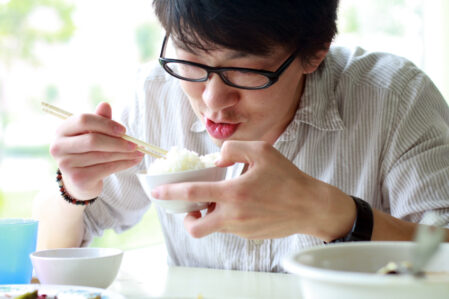
Asia encompasses a large geographic area, and food and flavor profiles vary widely across the diversity of Asian countries and regions. The food of each country differs based not only on availability of ingredients, but has been honed by environment, culture, tradition, history, philosophy and religion.
Nonetheless, there are a few commonalities, one being that traditional Asian diets are associated with low risk of many chronic diseases. In most Asian countries, the diet is low in calories, high in fiber with plenty of vegetables and limited animal protein. Rice, the oldest grain in the world, is the most important staple in the daily diet of most Asians. And hot tea is the dominant beverage to accompany Asian meals. Green tea, with its relatively high glutamate content is preferred over black and other teas.
The food, prepared in a manner to tempt the appetite, makes the fifth taste of umami of great importance. Umami taste is often developed by the addition of seasonings and fermented ingredients. During the fermentation process, proteins are broken down into their constituent amino acids, and a condiment rich in glutamate, the basis of umami, is produced.
The popularity of Asian food is illustrated by the fact that there are more Chinese restaurants in the United States than McDonald’s, Burger King’s, Wendy’s, Domino’s, and Pizza Hut’s combined. The popularity of Japanese sushi is an increasingly growing trend. The number of sushi bars in the U.S. quintupled between 1988 and 1998, and has kept on growing. The “What’s Hot in 2014” survey of 1,300 restaurant chefs by the National Restaurant Association found that Southeast Asian cuisine made the biggest jump in trendiness among ethnic cuisines, and Korean cuisine also made the top-five list in that category.
Culinary historians generally identify three main categories or types of traditional Asian cooking that have developed through the centuries, with much generalizations and some overlap:
The Northeast encompasses China, Korea, and Japan. Characteristic of the cooking is the use of fats, oils, and a large variety of sauces. Fermented soy sauce, rich in glutamate is in nearly every savory dish. Spices, herbs and seasonings go beyond being ingredients and many are used as medicines to promote a long and healthy life. The area’s southern region emphasizes freshness and tenderness. In the colder northern region, vinegar, garlic, and hot chilies are found. In Japan, kelp, seaweed, and fermented miso all add umami heft to the diet. Dashi, a basic stock made from kelp and fermented preserved bonito, is the umami-rich liquid used to prepare or finish many Japanese dishes.
The Southeast includes Thailand, Laos, Cambodia, Viet Nam, Indonesia, Malaysia, Singapore, and Brunei. The food is aromatic and lightly-cooked: quick stir-frying, steaming, and/or boiling. Spices and seasonings include citrus juices and herbs such as basil, cilantro, and mint, along with galangal, lemon grass, and tamarind. Fermented fish sauces such as Num Pla in Thailand and Nuoc Mum in Vietnam provide the all-important umami taste.
The Southwest covers India, Pakistan, Sri Lanka, and Burma. The food has its roots in Persian-Arabian civilization and in the Hindu beliefs, customs and practices practiced by the large population found in the region. A popular spice mix Chaat Masala encompasses all the five primary tastes: salt, sour, sweet, bitter and umami. Typically consisting of amchoor (dried mango powder), kala namak (black salt), dried ginger, and asafoetida (hing), it can be purchased pre-prepared, though many make their own and adding distinction through a wide variety other spices. Frequently used in cooking, chaat masala is most often added to food right before serving, and can be found in salads, snack foods, drinks, curries, daals and more.
Each Asian food culture has its own regional specialties with a huge diversity of flavors. All have a love of good tasting food to be shared in a tradition of gathering to socialize or celebrate over a big meal.

